
- Index
- Audio Inputs
- Aux (46)
- Blue Tooth (17)
- Coaxial Digital (4)
- Component (5)
- Digital Coaxial Rca (17)
- Ipod Dock (2)
- Line In (2)
- Multi-channel Rca (3)
- Phono / Turntable (2)
- Phono Input (3)
- Phonolinebal Line (3)
- Pre Out (4)
- Rca (29)
- Stereo L / R Rca (296)
- Stereo Rca (5)
- Tone Control (15)
- Two-channel Rca (8)
- Usb (7)
- ... (4386)
- Audio Outputs
- Brand
- Model
- Power
- Type
- A / V Receiver (4)
- Amplifier (154)
- Amplifiers (14)
- Bluetooth 2.0 Ch Amp (3)
- Digital Amplifier (4)
- El-84 Tube Amplifier (3)
- Enclosed Powered (5)
- Headphone Amplifier (20)
- Hi-fi Amplifier (20)
- Integrated Amplifie (3)
- Integrated Amplifier (1955)
- Power Amplifier (54)
- Stereo Phonic (3)
- Stereo Receiver (15)
- Tube Amp (3)
- Tube Amplifier (767)
- Tube Integrated Amp (3)
- Tube Preamplifier (11)
- Unknown (4)
- Vacuum Tube (12)
- ... (1797)
AudioValve Assistent 20 Valve / Tube Integrated Amplifier
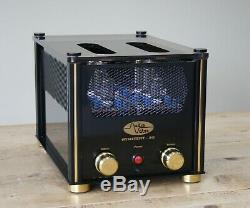
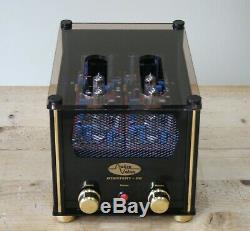
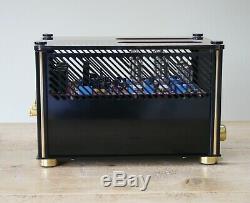
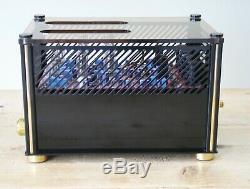
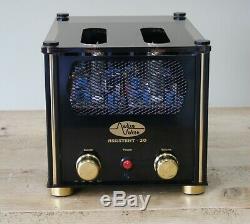
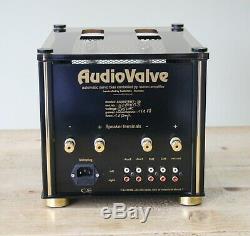
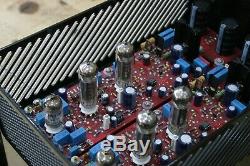
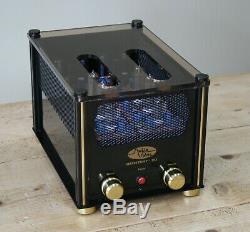
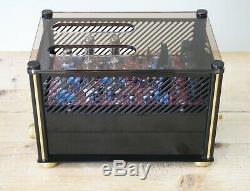


AudioValve Assistent 20 Valve / Tube Integrated Amplifier. Excellent condition and full working order. Power: 2 x 25Watt on 8 Ohm. Inputs: 4 (2 x CD, 2 x Aux). Sensitivity: 0,2 V and 1,5 V for 20 Watt.
Signal output sockets for recording. Dimensions: W 250 x H 240 x D 360 mm. QQE 03/12 or RS 1029 or CV 2798.
Audio Valve was born in 1984. This German firm first concerned itself with amplifiers for headphones and afterwards since 1990 has entered the market for valve amplifiers. Helmut Becker, a German engineer, had spent his leisure hours listening to music over electrodynamic headphones. That the quality of music derived from an amplifiers headphone output terminals was only mediocre, he became very quickly aware of.
He knew as well that on power amplifiers the headphone output signal was achieved through the utilisation of an attenuating resistance in the output circuit and therefore determinable for the quality a factor resulting in a compromised sound. The residual noise of the amplifier, almost inaudible over the majority of acoustic enclosures, became, over headphones unfortunately quite predominant, the latter requiring for their functioning less than fractions of one Watt.Further, he realised that in the CD players which have been on the market since 1983, the general practice has been to include a little integrated headphone amplifier. In some top range units a circuit with components discreetly constructed for quality was used but these were extremely rare. With these findings as a basis, this engineer decided to construct a headphone amplifier of very high quality for personal use. It soon became recognised, making an impression in its branch owing to its sheer quality.
Shortly this product reached the market as a kit and was described in revues in Elrad and Steroplay. In 1984 Helmut Becker founded the Company Audio Valve. In 1990 the range was extended and embodied a new appearance an aesthetic achievement based on a striking symbiosis of glass and black anodised aluminium. The annual demonstrations in a Frankfurt salon earned the product great acclaim and very quickly opened the way for a rapid increase in exports to Great Britain and Asia. In 1994 a completely new factory was built. Its very modern equipment enabled a further modification of the products, bringing them into line with the CE requirements for the European market. One of the original features of the Audio Valve products is to be found in the utilisation of the valves in such a way that they operate as closely as possible to their ideal reference values each according to its type. One recalls, for instance, the output pentode-triode PCL 805 and most particularly the small beam tetrode with a common cathode QQE 3/12. This valve with a noval (nine pin) base was manufactured formerly by Philips and Telefunken. (the latter was used in our test amplifier) It has a per plate power dissipation of 7,5 W and may be used with plate voltages ranging from 200 to 300 V.It is ideal in class A and AB amplifiers whereas used in class C the grid bias voltage may reach +30 V! This valve, according to Helmut Becker, is ideally adapted to be integrated in a circuit which includes another very innovative concept, an automatically operating grid bias control, refered to as "ABR" and used to great advantage in the integrated amplifier Assistent 20s. The Assistent 20s is one of the top products of the firm Audio Valve. In the near future we shall investigate the other products among which one finds the RKV, the amplifier for electrodynamic headphones, which was conceived at the time of the founding of the company. The classical chassis has been set into a caisson (a case-like frame).
The valves sit in their sockets mounted on a double side printed circuit board. Little columns support the glass cover preventing dangerous hand contact burns or electric shocks could ensue conforming to the CE requirements. The cooling is achieved through the sides. The controls mounted at the front consist of an input selector and a volume control the two channels being coupled in their operation. The height of the main board constituting the chassis enables the deeper positioning of the power supply and filter condensers as well as the output transformers. At the back are the cinch input sockets, two pairs of output terminals and a mains switch. The amplifying circuit uses only valves, but the push-pull output stages are coupled to the ABR circuit. This exclusive Audio Valve feature, allows a comparison of the reference voltage value with that engendered by the quiescent current and which appears at the terminals of a small value resistance in the return cathode circuit. A small operation amplifier monitors, as comparator, the divergence and deliverers the compensation voltage to the grid of the valve. Each valve, young or old, reaching reference values or not is thus compensated in its Grid bias to operate at a value which corresponds to its optimal quiescent currant. A red LED diode, at the foot of each value lights up preventing the use of inadequate or defect valves. For each channel the input stage and driver stage are served by an almost unknown noval valve, the American triple triode 6EZ8, whose bandwidth reaches 55 kHz. Listening to this valve amplifier from Audio Valve is a revelation for me. I have been completely taken aback (surprised) by the extraordinary profusion of information embedded in our every day (normal) discs. Of course other electronic devices reproduce the information, but in a manner more reserved and less natural. Here the minute details permeate the listening experience and it is real treat because this all remains so naturally integral in a certain way to the music.However, be advised on one matter: It is imperative to choose loudspeakers having a high efficiency, and, it goes without saying, of very high quality. Without a doubt the valve has not finished astonishing us! Australia, Hong Kong, Macau, Japan, Malaysia, Singapore, S.
52 42 35 - 19. The item "AudioValve Assistent 20 Valve / Tube Integrated Amplifier" is in sale since Sunday, February 10, 2019. This item is in the category "Sound & Vision\Home Audio & HiFi Separates\Amplifiers & Pre-Amps". The seller is "hi-fihouse" and is located in Bournemouth, Dorset. This item can be shipped worldwide.- Brand: AudioValve
- Type: Tube Amplifier
- Model: Assistent 20
- Number of Channels: 2
- Colour: Black
- Modified Item: No
- RMS Power: 25 wpc
- Country/Region of Manufacture: Germany

